Succulent Varieties
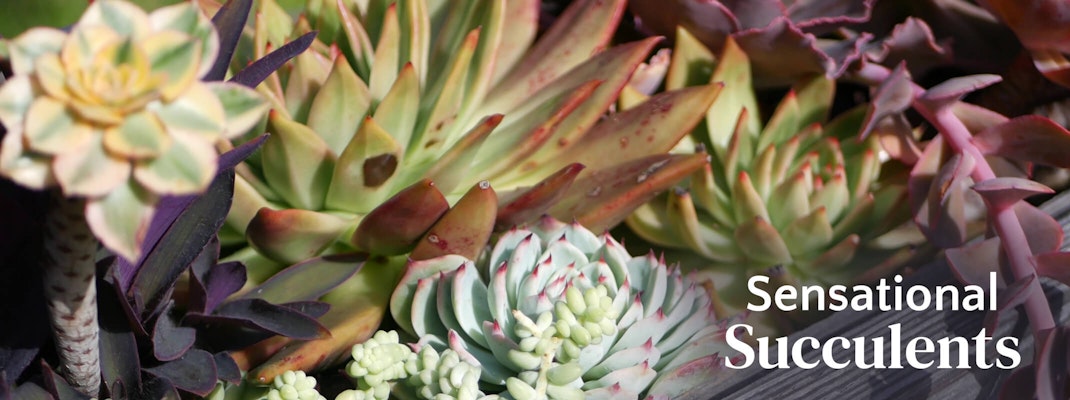
Intensely colorful, fleshy, architectural and easy to care for, succulents find their way into all kinds of horticultural applications: landscapes, dish gardens and garden containers, terrariums, vertical gardens, rock gardens, and along pathways. Succulents can provide interest to almost any area where there is adequate light.
Technically speaking, all cactus are succulents, but all cactus are not succulents. Cold hardy succulents like Sempervivum (Hens and Chicks and Delosperma (Ice Plant) create conservation-minded landscapes in all climates. More tender succulents like Aloe, Aeonium, Echiveria, Crassula (Jade) and Senecio are ideal for our climate and also make great indoor plants thanks to their ability to withstand dry, arid indoor conditions. Once gardeners discover the multitude of fascinating shapes and colors and how easy these plants are to grow, they can’t stop adding succulents to their planting palette.
12 Easy To Grow Succulents
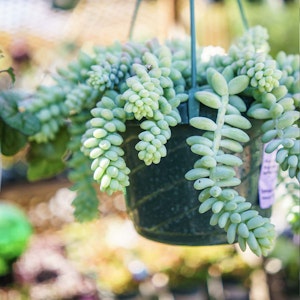
1. Burro’s tail
Sedum Morganianum - This succulent is a silvery lime green plant with wiry stems covered in short fat leaves. It makes a wonderful trailer in containers or all on its own in hanging baskets.
-
Propagation: Burro’s Tail is easy to propagate from leaf cuttings or stem cuttings. Simply remove a few leaves or a section of the stem, let it dry for a few days, then plant in well-draining soil.
-
Handle with Care: The leaves of Burro's Tail are delicate and can easily fall off when touched, so handle the plant gently when moving or repotting it.
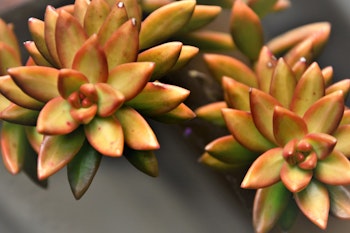
2. Graptosedum
'California Sunset' - The Echeveria like rosettes are blue-green, while the tips of the leaves are shades of orangish-pink that deepen with sun exposure. Easy to propatate.
- This plant prefers warmer temperatures and is not frost-tolerant. If grown outdoors, ensure it is protected when temperatures drop below 50°F (10°C). It can be overwintered indoors in cooler climates.
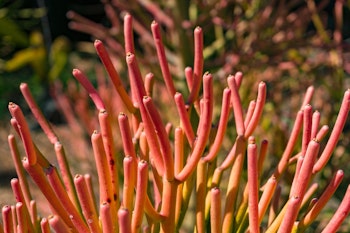
3. Pencil Cactus
Euphorbia tirucalli - This plant is also known as Milkbush (due to the cloudy sap it releases when injured). The branches are the diameter of a pencil, lending to the name. This plant LOVES the light and requires high levels of sun. New growth on the ends may be pink and host tiny leaves that disappear as the branch matures.
- Pencil Cactus thrives in full sun and requires bright, direct light to grow well. It can tolerate lower light indoors, but the vibrant colors are more pronounced with sufficient sunlight. For best results, place it in the sunniest location possible.<./li>
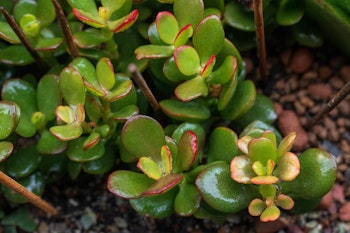
4. Jade Plant
Crassula Ovata - A very popular succulent, it tolerates some neglect and overwatering and does well in low light. The Jade Plant has oblong, fleshy, shiny, green leaves that may show red tints when grown in direct sun.
- Jade Plants are relatively drought-tolerant and prefer to dry out between waterings. Overwatering can cause root rot, so it's essential to ensure the soil is dry to the touch before watering again. In winter, reduce watering, as the plant goes into a semi-dormant state.
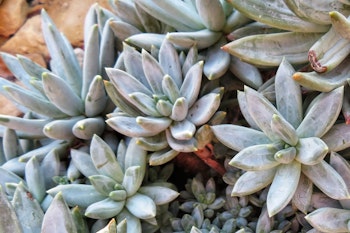
5. Pachyveria Glauca
‘Little Jewel’ - This succulent produces lots of new fun offsets. Tolerant of some overwatering, it’s relatively easy to propagate. The color is unique and is a beautiful accent to other succulents.
- 'Little Jewel' thrives in bright, indirect sunlight and will maintain its best color when exposed to plenty of light. Too little light may cause the plant to stretch and lose its compact form, while direct, harsh sunlight may cause sunburn.
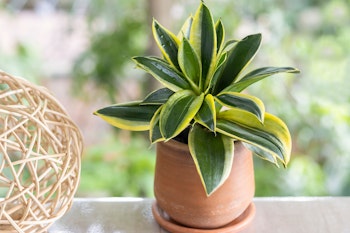
6. Snake Plant or Mother-in-law’s Tongue
Sansevieria Trifasciata - A plant that tequires very little light and water, but tolerates some overwatering. Unique color and shape make it a great plant all on its own or as the height in containers.
- Snake Plants are highly adaptable and can tolerate low light conditions, making them ideal for indoor spaces with minimal natural light. However, they grow best in indirect light, where their colors will be most vibrant. They can also survive in direct sunlight but may become more prone to leaf burn.
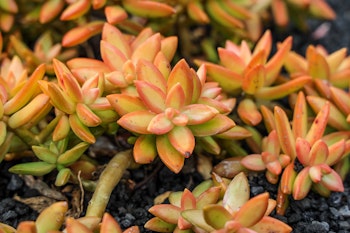
7. Coppertone Stonecrop
Sedum Nussbaumerianum - This succulent offers a stunning orange color in full sun. Very tolerable to heat, drought and even over watering. It even flowers pure white flowers in January through April. Easy to propagate.
- Coppertone Stonecrop thrives in full sun, which brings out its vibrant orange hues. In lower light conditions, the color may fade to a more muted green, so it's best to place it in a sunny location to achieve the best color display.
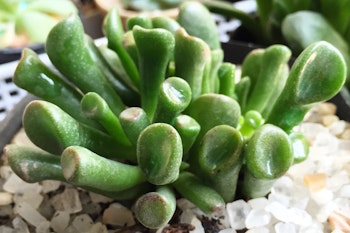
8. Crassula Gollum
This succulent is another variety of Jade Plant but this one has unusual tubular shaped leaves that become tinted red along their concave tips when weather becomes cooler. Tolerates neglect.
- Like most succulents, 'Gollum' is drought-tolerant and prefers to dry out between waterings. It can tolerate some neglect, making it a great low-maintenance plant. Avoid overwatering, as this can lead to root rot.
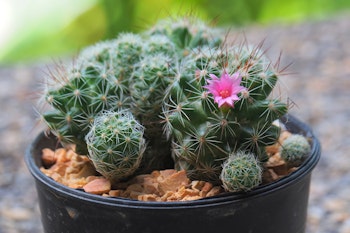
9. Thimble Cactus
Mammillaria Gracilis Fragilis - Very tolerant of drought. Acts as a great texture in container gardens and other arrangements. It is a small cactus with slender, cylindrical stems and chalky white radial spines.
-
Light: Thimble Cactus thrives in bright, direct sunlight. It requires at least several hours of full sun daily to maintain its compact shape and healthy growth. If grown indoors, place it near a sunny window to ensure it gets enough light.
-
Watering: This cactus is highly drought-tolerant and prefers to be watered sparingly. Allow the soil to dry out completely between waterings. Overwatering can cause the cactus to rot, so it’s best to water infrequently.
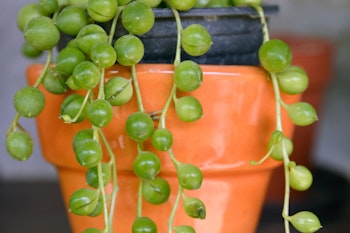
10. String of Pearls
Senecio rowleyanus - An easy succulent to grow indoors and out. The string of beads, that resemble a beaded necklace with fleshy green, pea-like foliage that sprawls over the edges of containers or hanging baskets.
-
Light: String of Pearls thrives in bright, indirect light when grown indoors. It can tolerate some direct sunlight but should be protected from harsh afternoon sun, which can scorch the leaves. Outdoors, it prefers partial shade.
-
Watering: This plant is drought-tolerant and prefers to dry out between waterings. Overwatering can lead to root rot, so it's important to ensure the soil is well-drained and not soggy. Water less frequently in the winter months when the plant’s growth slows.
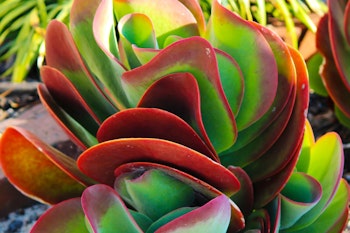
11. Paddle Plant
Kalanchoe thyrsiflora - This is an unusual-looking succulent, that grows in a rosette of flat, round leaves. It adds bold texture with gray-green leaves that will become tinged in red when exposed to sun.
-
Light: Paddle Plant thrives in bright, indirect sunlight but can also tolerate full sun, which brings out the red edges on its leaves. The more sun exposure it gets, the more pronounced the red tinges become. Indoors, place it near a bright window for the best color development.
-
Watering: Like most succulents, Paddle Plant prefers to dry out between waterings. Overwatering can lead to root rot, so be sure to allow the soil to dry completely before watering again. During winter, reduce watering as the plant enters a period of dormancy.
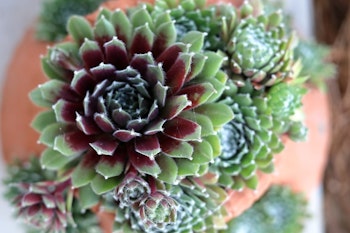
12. Hen and chicks
Member of the Sempervivum - Also known as houseleeks, these amazing little rosette shaped plants produce numerous babies (chicks). Sempervivum literally means “live forever” which couldn’t be more the case for these succulents that propagate easily. The grow well indoors and out, in cool or hot temperatures.
-
Light: Hen and Chicks thrive in full sun to partial shade. Outdoors, they grow best in bright, direct sunlight, which enhances the color and compactness of the rosettes. Indoors, they need a bright spot near a window with plenty of indirect light.
-
Watering: These succulents are highly drought-tolerant and prefer to dry out completely between waterings. Overwatering can cause root rot, so it's essential to ensure the soil drains well and doesn’t stay soggy. In winter, water less frequently as they go semi-dormant.
Succulent Planting and Care Needs
Light
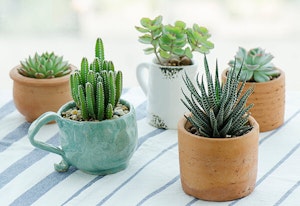
Succulents prefer bright light, such as found on a south-facing window. Watch the leaves for indications of correct lighting; some species will scorch if suddenly exposed to direct sunlight. The leaves will turn brown or white as the plant bleaches out and the soft tissues are destroyed. An underlit succulent will begin to stretch, with an elongated stem and widely spaced leaves; provide better light and prune the plant back to its original shape. Many kinds of succulents will thrive outdoors in the summer.
Temperature
Succulents are much more cold-tolerant than people might assume. Desert conditions feature marked contrasts between night and day, often with fifty degree variants. Succulents thrive in colder nights, down to even 40ºF. Succulents prefer daytime temperatures between 70ºF and about 85ºF and nighttime temperatures between 50ºF and 55ºF.
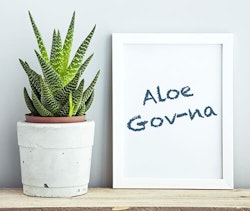
Water
Succulents need water in their growing seasons, Spring and Summer. Potting mix should dry between waterings, but do not underwater; the plants will stop growing, get brown spots on the leaves or lose their leaves without enough water.
During winter dormancy, cut watering back to once every other month. Overwatering results in plant rot, the single most common cause of plant failure. While an overwatered succulent might at first plump up and look very healthy, the cause of death may have already set in underground, with rot spreading upward from the root system. Don’t ever allow succulents to sit in water. Overwatered plants will discolor to yellow, white or otherwise lose their color and become soft. Succulents at this stage may be irreparable, but taking it from its pot, clearing way dead, rotten roots and repotting in dry media may preserve the plant. Cuttings can generally be propagated from the parent plant despite the damage.
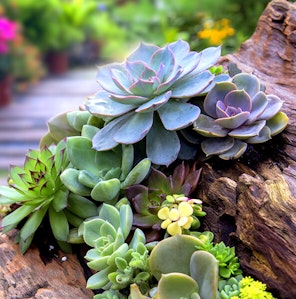
Soil
Succulents should be potted in a fast-draining mixture that's designed for cacti and succulents. Plants generally have shallow roots that form a dense mat just under the soil surface.
We recommend EB Stone Cactus Mix: an ideal potting mix for all types of indoor cactus and succulents containing Fir Bark, Lava Rock, Canadian Sphagnum Peat Moss, Sand, Redwood Compost and Mushroom Compost For vertical gardening with succulents and cactus, we recommend SummerWinds Natural and Organic Potting Soil to resist erosion and help retain water in vertical gardening containers.
Fertilizer
During the summer growing season, fertilizer as you would with other houseplants. Stop fertilizing entirely during the winter.
Schultz Cactus Plus Liquid Plant Food: for all cacti and succulents. Just 7 drops per quart of water dissolves completely and instantly.
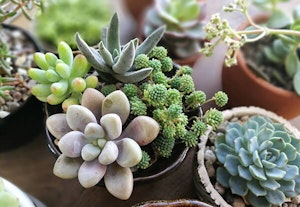
Propagation
Snap a rosette from the mother plant, leaving a piece of stem attached. Set the cutting aside in a dry, protected place, out of direct sun, until the cut end dries and seals (three days to a week).
Plant the healed rosette in loose, well-draining potting soil or succulent mix. Water regularly, letting soil dry out between waterings.
Gardening Essentials for Cactus and Succulents
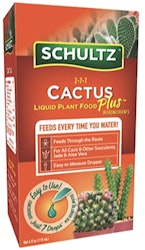
Schultz Cactus Plant Food
- 4 oz.
- Liquid Plant Food
- Plus Micronutrients
- Feeds every time you water through the roots
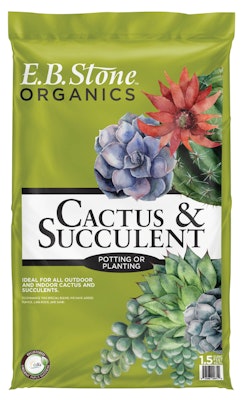
Cactus Mix
- E.B. Stone Organics
- 1.5 cu ft. Bag
- An ideal potting mix for all types of indoor cactus and succulents. Contains: Fir Bark, Lava Rock, Canadian Sphagnum Peat Moss, Sand and Aged Redwood.
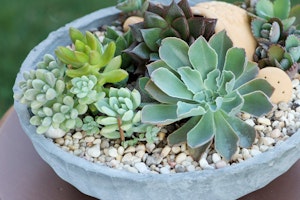
Low Container Bowls
- Assorted Sizes
- The color these bowls simply accent the beautiful colors of succulents and cactus.
Successfully Plant Succulents in Containers How-To-Plant
Looking for container gardening ideas with succulents? Sunset has 38 of them to share...
Succulents in Containers

